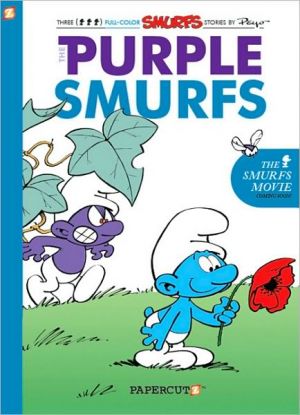Comics /
European Comics
The Smurfs Graphic Novel No. 1: The Purple Smurfs
By Leroy Douresseaux
August 2, 2011 - 14:25
 |
| The Purple Smurfs cover image is courtesy of barnesandnoble.com. |
People who know the Smurfs likely know them from the animated Saturday morning television series,
The Smurfs, produced by Hanna-Barbera Productions and aired on NBC from 1981 to 1989. New audiences are discovering them via the recently released summer film,
The Smurfs, from Columbia Pictures and Sony Pictures Animation.
However, the Smurfs began life in comics, created by the late Belgian comics artist, Peyo (the pen name of Pierre Culliford).
The Smurfs debuted in 1958 in Peyo’s Johan and Peewit comics series, in the storyline,
The Flute with Six Holes (now entitled,
The Smurfs and the Magic Flute). The Smurfs were immediately popular and started appearing in their own comics series in 1959.
Eventually, those Smurf comics were reprinted in graphic albums (novels), and the first was
Les Schtroumpfs noirs (The Black Smurfs). Although the Smurfs graphic albums were eventually published in English in the United States, they had long been out of print. In 2010, Papercutz, the all-ages graphic novel wing of NBM, brought the Smurfs back to American comics.
The first release is
The Smurfs Graphic Novel No. 1: The Purple Smurfs. This is an English edition of
The Black Smurfs, but with the black Smurfs re-colored purple. The Purple Smurfs contains three stories: “The Purple Smurfs,” “The Flying Smurf,” and “The Smurf and His Neighbors.” There is also a preview of The Smurfs Graphic Novel No. 2: The Smurfs and the Magic Flute, as well as an after word by Papercutz Editor-in-Chief, Jim Salicrup.
THE LOWDOWN: I’ve wanted to read the original Smurf comics for over two decades, and even after that long wait, I am not at all disappointed. These are delightful children’s comics, but there is an oddness and an eccentricity about The Smurfs comics that will make them enjoyable for older readers.
The Smurfs are at once tribal and social, but are also fiercely independent. Most of the time, they refer to one another as Smurf (as in “Hey, Smurf” or “Find that Smurf”), but they also clearly recognize each other’s individualism and unique personalities.
The Smurfs are little problems solvers, but they often make their own problems. The lengths to which the Smurf who wants to fly is willing to go to fly yields comedy gold. The title story (“The Purple Smurfs”) is surprisingly a thriller dressed as slapstick comedy. “The Smurf and His Neighbors,” an ode to the yearning to escape the noise of civilization for the quite and solitude of the wild, is like a little morality tale. I can’t pick a favorite of these three stories; each is fantastic in its own right.
This little hardcover, the size of a standard comic book, is the kind of comic book to pass on to new, young readers. The stories within, however, will inform readers why the Smurfs have such staying power.
POSSIBLE AUDIENCE: Longtime comics readers who are looking for a reminder of why comics are fun to read will want The Purple Smurf.
A
www.smurf.com
www.papercutz.com
Read more of me at www.negromancer.com.
Last Updated: January 17, 2025 - 08:20
